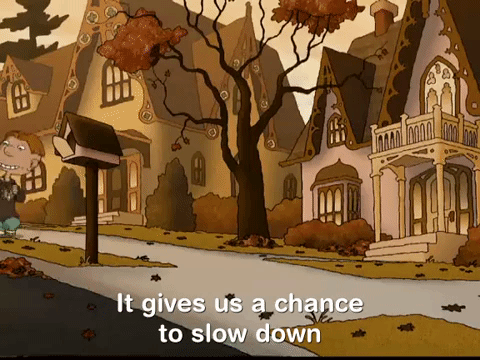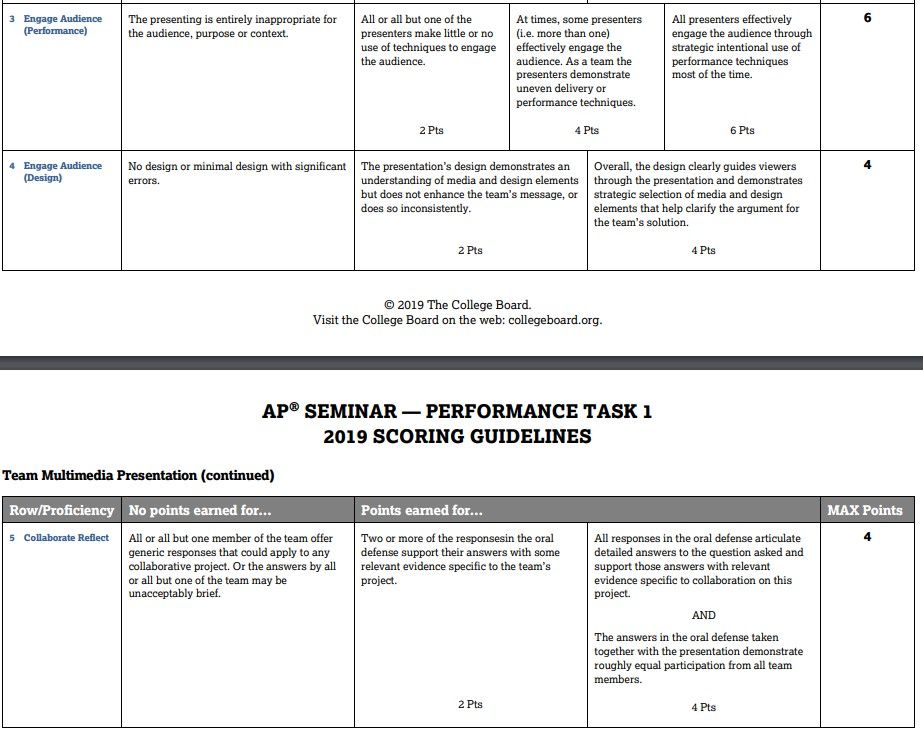5.0 Big Idea 5: Team, Transform, and Transmit
8 min read•november 15, 2020
Steven Kucklick
AP Seminar 💬
13 resourcesSee Units
Overview of Big Idea 5
It's time to team up for the last Big Idea!

Image Courtesy of Giphy
This last Big Idea is all about how to work ✍️ productively with your team to create a polished finished project and present that to an audience.
Even though you will only be working with a team for Performance Task 1, you will still be using elements of Big Idea 5 in Performance Task 2 and all other work you do for Seminar.
Quick Tip: It's easy to get hyper-focused on the Performance Tasks and forget about the other things that make up Seminar. The goal is not just to successfully complete PT 1 and PT 2, but to also learn and practice the skills that the Big Ideas are based around.
There are two main ideas that make up Big Idea 5: your audience 👨🏫 and your team. These are what the essential questions are based around and what we will be focusing on in this guide. Speaking of essential questions...
Essential Questions of Big Idea 5
The Essential Questions of Big Idea 5 are some of the most straight forward, but that does not mean we should spend less time ⏰ looking at them.
- How can I best appeal to and engage my audience? 👨🏫
- What is the best medium or genre through which to engage my audience? ✍️
- What common misconceptions might my audience have? 🧐
- How might I adapt my argument for different audiences and situations? 👀
- How might I adapt my communication choices affect my credibility with my audience? 👨🎓
- What contributions can I offer to a team? 👍
- What is the benefit of revision? 😎
- How can I benefit from reflection on my own work? 🤔
It's easy to see how the two big topics for these essential questions are the audience and your team, and that is how we are going to break them up.
How to Engage Your Audience
Successfully engaging your audience is critical in 'selling them' 💰 on your topic and argument. Engaging your audience is not just about the language you are using, but also how you speak, how you design your presentation, and the way you structure your content.
The first two EQs are focused on this idea.
Getting Your Audience to Understand
The biggest thing to remember about audience engagement is that you know your topic, but you can't assume that your audience does. 🧐
Think critically about what needs to be explained or defined so that your audience is on the same page as you. The worst mistake you can make is not defining an idea causing your audience to become totally lost and not listen to what you're saying.

Image Courtesy of Giphy
The best way to fix this is to practice ✍️ your presentation (you're going to see this advice a lot in this unit guide...). You only have one chance to give your presentation to your teacher, but you have unlimited opportunities to practice it in front of other people!
Parents, other teachers, and even your own classmates 🙋♀️ can be valuable resources to help you tighten up and master your presentation. I'm sure you can even convince some friends to listen to a ten-minute presentation. And chances are if your friends don't understand your topic, you won't get max points.
How to Be a Good Presenter
You may have the perfect sources, the best claims, and rock-solid argument, but that means nothing 🙅 if you don't properly present. This goes beyond reaching your audience (like we talked about above); instead, this is about how you physically present.
Convincing an audience of your argument has just as much to do with your body language 💁 as it does with your data and evidence. Below is a list of things you should keep in mind while you are presenting to an audience.
- Speak loud and slow. If you feel like you're talking too slow, odds are that you are probably speaking at a good pace. 👨🏫
- Try to make eye contact with your audience regularly, but don't feel like you have to maintain eye contact throughout the entire presentation. 😎
- Body language says a lot about confidence. If you are able, stand up straight and keep your shoulders open. Also, make sure that you do not turn your back to the audience. You can reference something on your slides, but do not read directly from them. 🤷♀️
- Do your best to enunciate your words and try not to mumble! 🤔
It's easy to get overwhelmed and nervous, but that's why it is so important to practice! Another good tip is to practice in front of a mirror so you can get a sense of your facial expressions and how your are standing.
How to Appeal to Your Audience
Essential Questions 3, 4, and 5 have you think about how well your presentation is catered to your audience. Knowing who makes up your audience 👨🏫 is crucial to creating a convincing and effective presentation.
In AP Seminar, you will know who you are presenting to. Is it just your teacher? Is it your teacher, the principal, and a community member? These are all questions you can and should ask before you present. 🤔
In general, though, you should always assume that your audience has very limited background knowledge about your subject. This goes back to what we talked about above, make sure you cater your presentation to your audience.
Also, think about any assumptions that your audience may have. Is your topic widely debated? Is it a hot button issue that most people have an opinion on? These are things that you should keep in mind.
Being a Good Teammate
Having good team chemistry 💯 is one of the easiest things you can do in Performance Task 1 that has a massive impact.
I'm sure you've worked with a group in the past, and it went terribly. One person didn't do what they were supposed to, and the whole thing fell apart. We've all been there. But, I am going to tell you the secret to having a successful team. Are you ready??
COMMUNICATION!!! 🗣️
That's right, it's that simple. Good communication will make or break a team. Here are a few pointers to make sure that communication goes off without a hitch.
- Have a text message group so that you can quickly communicate with your teammates. 💻
- If your teammate makes a suggestion or a statement, make sure you respond to it to signify that you saw their message or heard them. 👍
- Check-in with your team at least every other day. You will be working on your Individual Research Report alone, but you should still keep your team in the loop. 🤔
- Do not make any major changes to your PowerPoint or script without talking to your team first. ✍️
- If someone in your team isn't doing what they are supposed to be doing, do not accuse them or pass blame. Ask them if they need help or are having problems. Passing blame can often lead to fights. You can always go to your teacher as well. 👨🏫
- Websites like Slack, Notion, and Trello make working in a group SO MUCH EASIER. Google Docs is great, as well, but can be super messy. Just find a website and program that works for you! 👀
- When in doubt, talk it out! You will get nowhere if you bottle up concerns or questions. 🗣️
Working in a team can be very challenging, but guess what? You will be doing it the rest of your life! Most jobs require some level of team and employers want to hire people who have good teamwork skills. Work on these skills and I promise you will see success!
Self Reflection
The last aspect of Big Idea 5 is one of the most important: reflection. This idea is all about thinking about what you did right, what you did wrong, and what you would do differently in the future. 🤔
As you work through all of your practice and your Performance Tasks, you should be practicing this self reflection. This seems easy, but the hard part is accepting your reflections and making changes based on them.

Image Courtesy of Giphy
This reflection can be done in a lot of different ways. You can meditate for five minutes at the end of the week, reflecting on what you did right and what you would like to change. You can keep notes that you take as you're working. You can meet with your teammates and your teachers to talk about the work you've done. As long as you're reflecting, you're doing what you need to do. 👍
You do need to put these reflections into action, though! Make sure that you are working to change and adapt to the mistakes that you make along the way. Reflecting is great, but it doesn't do much if you don't make changes!
How Big Idea 5 Relates to the Exam
Big Idea 5 mostly shows up in the presentation sections of the two Performance Tasks. Let's take a look at the rubrics.
Performance Task 1

Source: College Board Rubrics
Looking at the rubric above we can see that 14 points are devoted to Big Idea 5. The first two rows are all about how you engage your audience. Make sure that you are using the tips that I listed above to achieve all six points.
Once you are done with your presentation each team member will have to answer a question relating to the presentation or the research process.
Quick Tip: These questions are predetermined and can be found in the Course and Exam Description on page 48.
The answers to these questions need to be specific and can't just be general statements. But, if you've been communicating with your team, they should be easy!
Performance Task 2


PT 2 uses Big Idea 5 in a very similar way as PT 1. The main difference that we need to note is that the Oral Defense is a little more complex. You will be answering two questions that, again, you need to answer with specific evidence.
Quick Tip: Oral defense questions can be found in the Course and Exam Description on page 52.
In Conclusion
Big Idea 5 covers the stuff that helps PT 1 and PT 2 run smoothly. It may seem like small potatoes compared to the other Big Ideas, but don't count it out! If your team isn't operating at its best, the rest of PT 1 will fall apart. If you aren't reflecting on the mistakes you made, you won't improve. Plus, you will use the ideas in Big Idea 5 in other aspects of life! 😎
Browse Study Guides By Unit
🤨Big Idea 1: Question and Explore
🧐Big Idea 2: Understand and Analyze
👥Big Idea 3: Evaluate Multiple Perspectives
💡Big Idea 4: Synthesize Ideas
🗣Big Idea 5: Team, Transform, and Transmit
✏️Frequently Asked Questions
📝Exam Tasks & Guidance

Fiveable
Resources
© 2023 Fiveable Inc. All rights reserved.